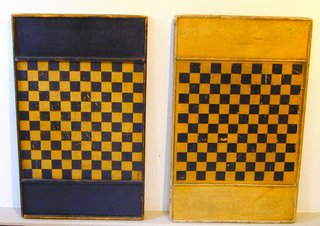
Earlier I spoke of folk art, and the many different kinds available. A very popular kind of folk art collecting is gameboards. There are all sorts of game boards available, in a zillion styles, shapes and colors.
Gameboard collectors like unusual styles, bold colors, and unique, homemade game boards, and will pay high prices for something really different. If you are interested in colorful folk art, gameboards might be a fun category to search for - here's some tips on buying an honest, good-quality folk art game board.
Above are two interesting checker gameboards, unusual because they mirror each other yet are individual in their own design. Their bold colors yet simple style make them wonderful decorative art.
They are being sold together, and were probably made by the same maker. They show no maker's name, typical of homemade gameboards. They are from the early 19th century, and they are Canadian.
Now, if they are unmarked, how would I know where they originated? By recognizing the specific design of these boards. Checker boards are usually seen in two styles - one style has eight squares across the top, while the other style has twelve squares. By counting the number of squares across the width of the board, the probable origin can be determined. Eight squares across the top indicates an American checker board, while twelve squares most likely means it's a Canadian board.
Another attractive feature of these boards is the "holding" area for checkers at each end of the boards. It indicates an earlier board, versus a 20th century board. The square nail construction also reflects these board's 19th century age. These have not been repainted - their original paint, dry and showing good crackling - make them even more desirable.
Fun to see a matched pair of boards - it's not often a collector has an opportunity to obtain a pair. These were found in a local Maine antiques shop, one well-known for it's Folk Art offerings.










No comments:
Post a Comment